Michael Field’s “Equal Love”: A Work of Trojan Horse Feminism
©2019 Brendan Wallace, Ryerson University
Historical Context
Introduction
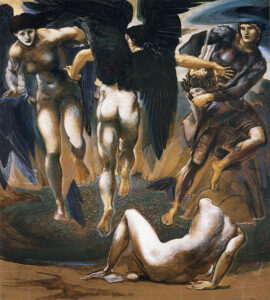
The end of the nineteenth century was a time shaped by both the death of exhausted ideals and the energy of avant-garde innovations in social thought (Knight 12). The period was marked by an environment recognizably fertile for change. Katherine Bradley and Edith Cooper disavowed the marginalization of women that pervaded Victorian society and saw the opportunity to redress it during this period of upheaval (Thain 13). However, despite the time being notable for experimentation, women were still not afforded any considerable merit in the public eye; the exploration and development of culture remained the domain of titled men (Ledger 36). Such were the conditions that led to the conception of Michael Field, the male pseudonym Bradley and Cooper published under, and so too began their subterfuge.
Field’s play entitled “Equal Love,” published in The Pageant 1896, is an example of their textual feminist activism. The Pageant was one of many 1890s era periodicals prized for its subversive texts and openness to dissident ideologies (King). However, it also had commercial intention and was crafted to be more respectable in the public eye, earning it broader readership (King). The Pageant was to bring aestheticism to the masses, including those who did not necessarily support the movement’s anti-Victorian morals. This combination of qualities served Field well as an author who “simultaneously revealed and concealed” the politics within their works, including “Equal Love” (Thain 15).
Significant to the conceptualization of The Pageant was the aspiration to create a “Total Work of Art” (King). In part, this was achieved by intermingling imagery and text that, although discrete in source, cannot be considered in isolation. This analysis aims to elucidate how the Grecian themed artworks bookending and embedded within “Equal Love” bolster the efficacy of the feminist agenda espoused by Michael Field throughout the play.
Greek Influence on Victorian Culture
In order to understand the impact of Greek art within The Pageant and “Equal Love,” its significance to the Victorian context must first be understood. Greek culture and classical studies formed the curricular backbone of higher education throughout most of the Victorian period (Jenkyns 280)—Greek study “gave the Victorian age its religious, moral and political tone” (Jenkyns 65). As such, it can be surmised that Greek symbolism had both resonance and the power to influence amongst the educated of the age. Furthermore, these qualities would have been associated primarily with men, considering the limitations women faced in accessing schooling (Hollis 140). Ergo, Greek myth and symbolism were important markers of social status in Victorian England, with a notably masculine hue.
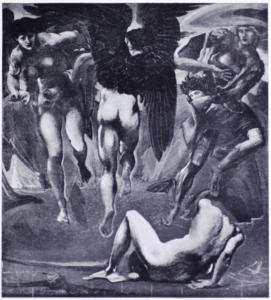
Grecian Symbolism & Subversion
Field faced the obstacle of enticing those adherent to the status quo—and benefiting from its maintenance—to empathize with the feminist movement and alter their own beliefs accordingly. To do this, subtle subversion was necessary. By situating “Equal Love” between recognizable characters of Greek myth, such as “Perseus and Medusa” (fig. 2) and Athena in “Pallas and the Centaur” (fig. 3), Field is tapping into a common cultural pool of knowledge and attaining familiarity, thus making the (male) reader more comfortable. This functions in tandem with the medium of periodical-bound-play itself, as fantasy tends to be more approachable and unassuming than, say, a manifesto.
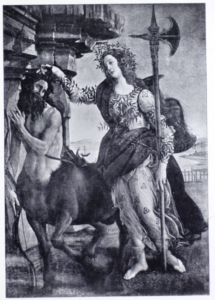
The importance of securing male readership was kindred to the disparity in educational access. Those holding positions of political power—the men who could actually improve the legal rights of women—were the same men who had attended universities and received an education in Greek study. It can be understood, then, that the placements of these works of Greek imagery were intended to act somewhat like a Trojan horse, carrying the disruptive cargo of female empowerment through the gates of patriarchal English society.
It is important to understand that, while I have been accrediting the positioning of works to Field, it would have actually been the combined efforts of The Pageant’s literary editor, Gleeson White, and art editor, Charles Shannon (King). However, for the sake of simplicity and because it is impossible to say who actually made what decision, Field will be named in this role. Merit to this simplification is found in the knowledge that Shannon and Field were close friends and collaborators (King), as well as that Field used Greek art in the stage setting, a recognizable continuation of the effect detailed above and one that will be elaborated on below.
“Equal Love”
Ostensibly the tale of Byzantine emperor Justinian pressuring empress Theodora to commit infanticide — Properly a critique of Victorian culture and its subjugation of women through marriage.
Stage It, Don’t Say It!
Before the dialogue begins, the stage is set with two large sculptural implements. In the room, “a bronze statue of Ariadne Sleeping” (fig. 4) is facing “a bronze Saint Chrysostom” (fig. 5) as if they are frozen in discussion (189). The figure of Ariadne is a female seemingly halfway between sleeping and wakening—suggestive of Field’s view on women in Victorian society—whereas Saint Chrysostom was iconic for denouncing abuses of power, including within marriage (Schroeder)—carrying the idea of overt political action as well as an ideological direction to heed. Non-coincidentally, Ariadne is a figure of Greek myth while Saint Chrysostom was born to Greek parents. This staging is indicative of a call for the politically dormant women of England to rise in protest against the powers presently oppressing them, cloaked in welcomed Greek ambience.
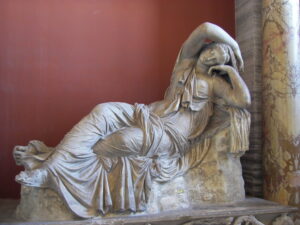
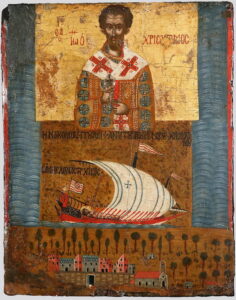
An additional stage feature of “golden columns” (189) calls to mind Greek architecture, linking the play to Greek culture. This, in turn, links “Equal Love” to contemporary culture, as per the aforementioned Victorian fixation. By paralleling Byzantine and British culture through shared stylistic sensibilities in statue and architecture, “Equal Love” is able to act as a palimpsestic allegory.
The actual genre of “Equal Love” is, however, a closet drama, meaning a play not meant to be performed on stage (Vadillo 237). Field is thus calling attention to the set design to import an elevated significance unto “Equal Love,” marking it as valuable in accordance with Victorian sensibilities, as “Greek was the stamp that authenticated culture and class” during the period (Jenkyns 63). This is a recognizable continuation of the intention, initiated by “Perseus and Medusa,” to entice educated men to engage, unbeknownst, with the subversive text.
The royal setting is clever for another reason too. It was a popular position among 1890s feminists that marriage should be a personal agreement and not a legal one (Ledger 22). By casting “Equal Love” with royal players, Field abolishes the potential for legal interference—king and queen have no higher authority to take example from. Field thereby crafts a setting in which the New Woman ideal of marriage as a co-operative undertaking can be demonstrated to Victorians. Before unpacking that though, it is first necessary to meet the married couple.
Justinian as Victorian Britain
In order to understand how the characters of “Equal Love” operate in critique of the contemporary English society, it is imperative to understand them as representative. First, Field uses the character of Justinian to embody Victorian cultural values. Justinian is titled the “Emperor of the East and West” in the character listing for “Equal Love” (189). Britain’s throne also claimed rule over the East and West at this time of colonial supremacy (Childs 10). Justinian also says he is “ruler / … of half the world” (202), seemingly echoing the slogan of the British Empire: “The Empire on which the sun never sets.”
Furthermore, Justinian exemplifies oppressive masculinity when he says to Theodora “[y]our majesty / Is in my worship” (196), a statement in which he attempts to hold command over how his wife defines her value. Behaviour of this sort was typical of Victorian England; the New Woman movement was a concomitant of the attitude.
Theodora: The New Woman
Women in Victorian culture were classically dichotomized as being either “the angel in the house” or “the streetwalking whore” (Ledger 42); the public distinction was oft dependent on whether she was accompanied by a man. Theodora represents both sides of this dichotomy, given that she has lived both as a prostitute, in the past she shares with Antonia (191), and as the highest iteration of the spousal role, as empress to Justinian. Occupying both possibilities generalizes Theodora, allowing her to represent all Victorian women.
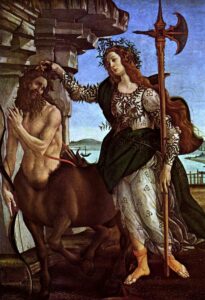
The New Woman movement was in reaction to the ethos of this dichotomy; she was a fictional concept as well as an artist—an archetype and an embodiment—who strove for gender equality (Ledger 1). One key aspect of the New Woman movement was winning independence—having the potential to live a fulfilling, unwed life (Knight 14). This demand led to considerable worry that the New Woman would no longer need men and would thereby ignore them outright (Ledger 5). However, although some women denounced the institution of marriage entirely, most sought improvement in the rights of married women, alongside a viable and respectable alternative to marriage (Ledger 22).
Improved freedoms were important as both sex-workers and domestic slaves were considered to be parasitically dependent on men (Ledger 42). While Theodora represents both dichotomies, Field also demonstrates that she is not parasitic through her flight of independence, in which she “learnt to spin” (201). By occupying neither womanly role and freeing herself from the influence of men, she discovers empowerment. Through acquisition of a craft skill, Theodora shows a functional alternative to the dichotomy and thus becomes Field’s example of the New Woman in practice.
With Justinian established as a stand-in for Victorianism and Theodora as a stand-in for the New Woman latent in all Victorian women, Justinian’s interactions with Theodora in “Equal Love” can thus be considered the effect of Britain, as a set of Victorian ideals, on the women of the nation. Field then mobilizes these characters to examine British marital practices.
The Matter of Marriage
A major topic Field reproaches in “Equal Love” is the disparity between the marital rights of women and men. Ledger describes the Victorian ideal of a wife as a possession desired for her youth and innocence (115). Being valued primarily for these qualities meant that women were discouraged from pursuing individual development, for fear that experience would leave them unfit for marriage. Theodora stands apart from this ideal as per her “tremendous days of revelry / [i]n the arena” in which she engaged with the public as an autonomous adult, having “so many lovers” that she “did not stay to choose” (191). Nevertheless, she is a fine wife, having “failed to act [her] part but once” (213). Furthermore, Justinian is aware they met “not as virgin souls” but “[a]s weary, cynical,” yet still “found a rapture in [his] life” when he “wedded [Theodora]” (196). Field is thereby rejecting the notion that women should be limited in their opportunity so as to remain desirable by showing Theodora to be an enviable bride in spite of her worldliness.
In order to establish their proof that women are not devalued by experience, Field maintains the problematic position of objectification—Justinian “heard praise of [Theodora’s] beauty, and [he] came / [c]oldly to take [his] pleasure” (196). By using the verb take, Field overtly propagates hegemonic thought of spousal ownership, in order to sneak in their subversive message of empowerment. However, this is not an act of compromise but a further chance for Grecian referral to garner subversive impact.
The play is interrupted on the ensuing pages by “Death and the Bather” (fig. 7). This artwork is of recognizable Greek influence, featuring a man, reminiscent of Narcissus, lost in his watery reflection. Given the title, the act of vanity is presumed to be of fatal consequence.
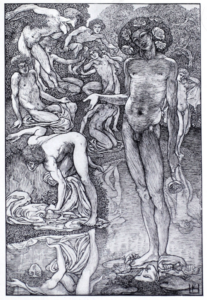
The purpose of this image can, therefore, be considered a warning against the pursuit of material beauty, suggesting it to be an illusory objective that will spell demise for those who pursue it. The positioning is clearly referent to Justinian’s (Britain’s) treatment of women as accessories of vanity. Field thereby mobilizes Greek art once more to be dissident to the ideals of the age whilst appearing innocuous, and even haphazard, in its incorporation.
Following “Death and the Bather,” “[Attendants are summoned, and carry out the / body of the child…]” (202). The absence of the child frees Theodora—the New Woman—from the responsibility of childcare. Childbearing and rearing were considered the primary functions of women, reducing them to biological capital (Abrams 6). By removing the child, Field enables Theodora to explore alternatives that proponents of the New Woman movement yearned for.
Justinian presents such an opportunity when he invites her to “work / [a]t the great laws together” (203). Here Field shows the New Woman as a capable equal in the shaping of important laws, a stark contrast to the “taxation without representation” reality of the time (Nelson 42). Field advances their argument to focus on “[t]he marriage-contract,” of which Theodora says “[t]here must be more freedom / [f]or women, as I urged” (204). Field essentially breaks the fourth wall and points directly at the contemporary problem from within the text. The blatancy of Theodora’s dialogue represents a change of tone in “Equal Love;” confident that the reader has been lulled by the common motifs of the story and staging, Field is able to make direct demands on the present in a way that is not objectionable.
Conclusion
The incomplete nature of female lives in Victorian England formed the primordial grounds from which “Equal Love” came. As a result of their disparate position from male aesthetes and authors, Katherine Bradley and Edith Cooper were uniquely qualified to accurately evaluate the social structure that the male-majority of public and published voices were ensnared by. From this position, Field addresses gender inequality in a way that demonstrates the implementation of the New Woman ideal, through Theodora, to be a positive move, if not a necessary evolution in social thought. Finally, Field’s use of Greek symbolism to inveigle male readers is a useful lesson to this day, a present shaped by global problems abetted by global powers. In “Equal Love,” Field templates one potential avenue to alter the discourse, and thus the minds, of many—the method of subtle subversion.
Works Cited
Field, Michael. “Equal Love.” The Pageant 1896, Henry & Co., 1895, pp. 189-224. Yellow Nineties 2.0, https://archive.org/stream/Pageant1896_201609/Pageant1896#page/n207/mode/2up.
Secondary Sources:
Abrams, Lynn. “Wife and mother.” Ideals of Womanhood in Victorian Britain, British Broadcasting Corporation, 2001, p. 6. BBC History, https://www.bbc.co.uk/history/trail/victorian_britain/women_home/ideals_womanhood_06.shtml.
Childs, Peter and Patrick Williams. “Introduction: Points of departure.” An Introduction to Post-Colonial Theory, Prentice Hall, 1997, pp. 1-23.
Hollis, Patricia. Women in Public: The Women’s Movement 1850-1900. Allen & Unwin Ltd, 1979, p. 140.
Jenkyns, Richard. The Victorians and Ancient Greece. Harvard University Press, 1980.
King, Frederick D. “The Pageant (1896-1897): An Overview.” Pageant Digital Edition, Yellow Nineties 2.0, edited by Lorraine Janzen Kooistra, Ryerson University Centre for Digital Humanities, 2019, https://1890s.ca/pageant_overview/.
Knight, Frances. Victorian Christianity at the Fin de Siècle : the culture of English religion in a decadent age. I.B. Tauris, 2016.
Ledger, Sally. The New Woman: Fiction and feminism at the fin de siècle. Manchester University Press, 1997.
Nelson, Carolyn Christensen. “The Arguments.” Literature of the Women’s Suffrage Campaign in England, Broadview Press, 2004, pp. 37-43. Scholars Portal, https://books-scholarsportal-info.ezproxy.lib.ryerson.ca/en/read?id=/ebooks/ebooks0/gibson_crkn/2009-12-01/3/405108#page=84.
Schroeder, Joy A. “John Chrysostom’s Critique of Spousal Violence.” Journal of Early Christian Studies, vol. 12 no. 4, 2004, pp. 413-442. Project MUSE, doi:10.1353/earl.2004.0067.
Thain, Marion. “Introduction: ‘something fierce, subtle, strange, singular’.” ‘Michael Field’ : Poetry, Aestheticism and the Fin de Siècle, Cambridge University Press, 2007, pp. 1-19.
Vadillo, Ana Parejo. “Outmoded Dramas: History and Modernity in Michael Field’s Aesthetic Plays.” Michael Field and Their World, The Rivendale Press, 2007, pp. 237-248.
Images in this online exhibit are either in the public domain or being used under fair dealing for the purpose of research and are provided solely for the purposes of research, private study, or education.
